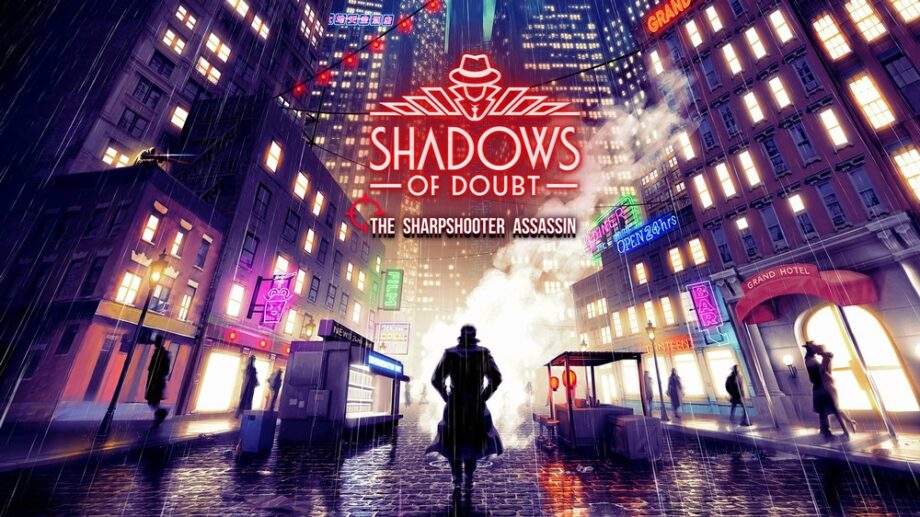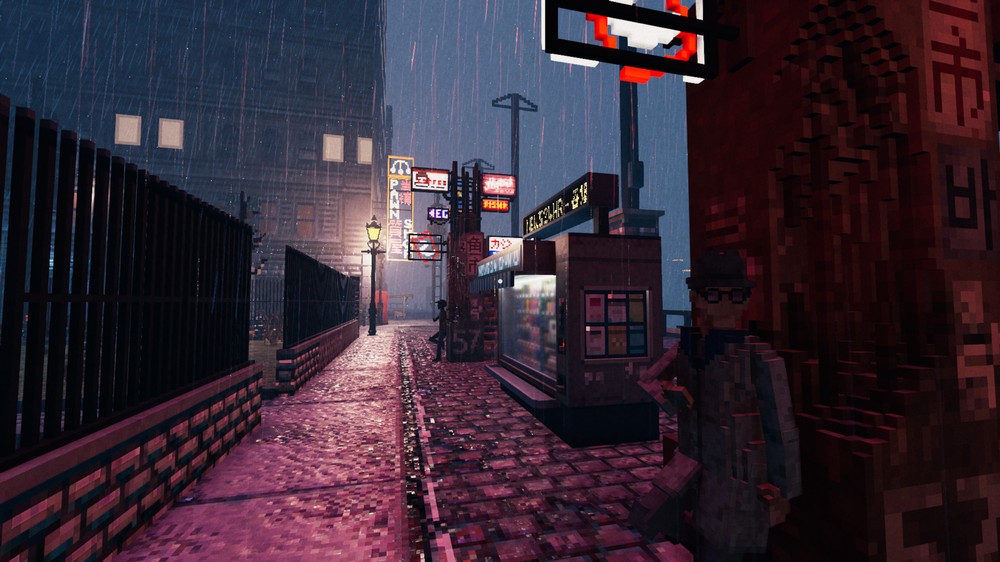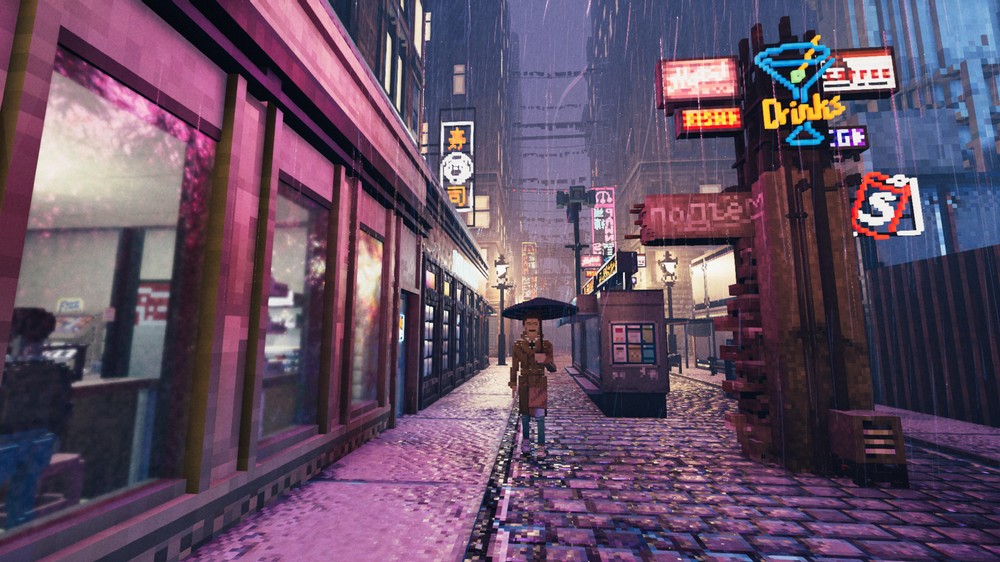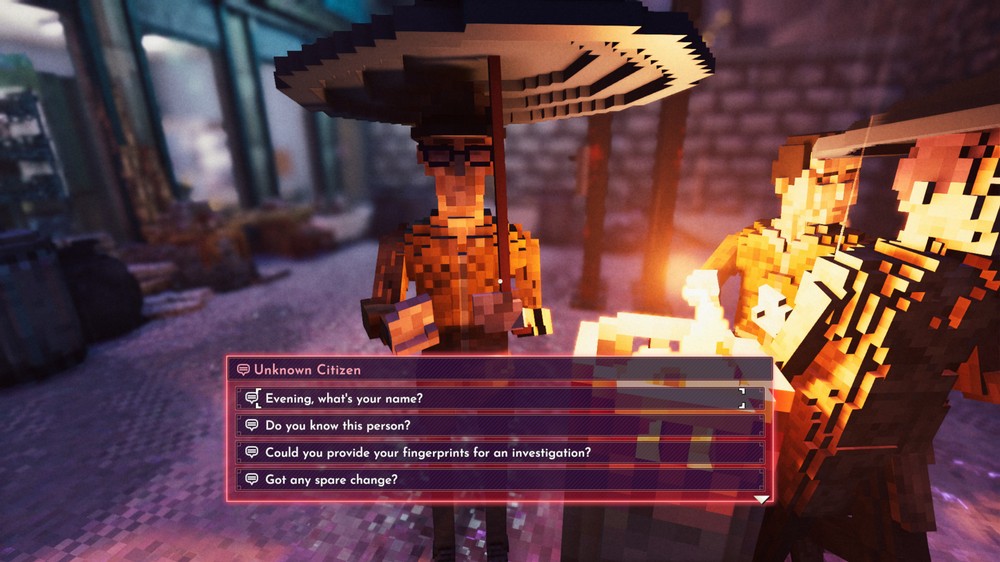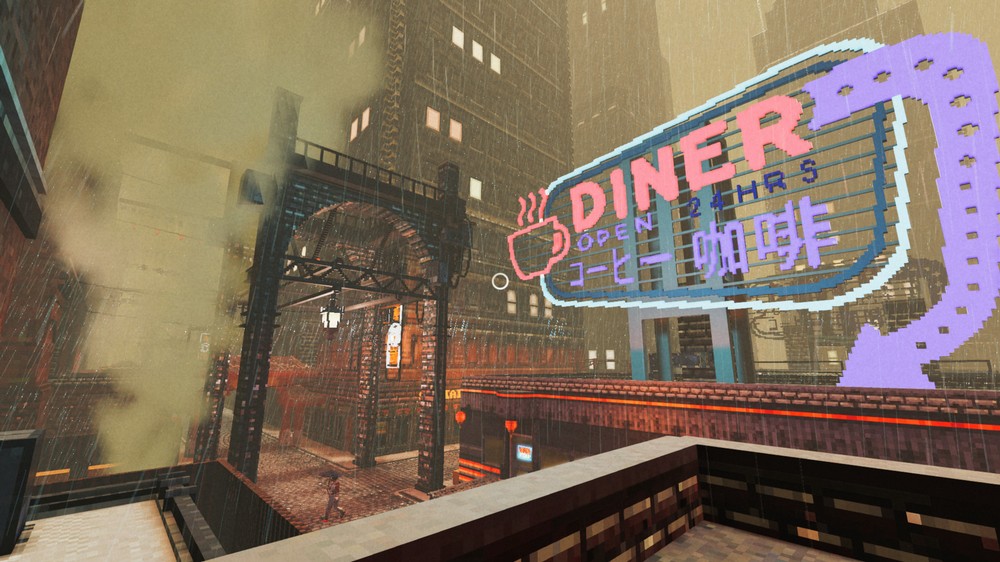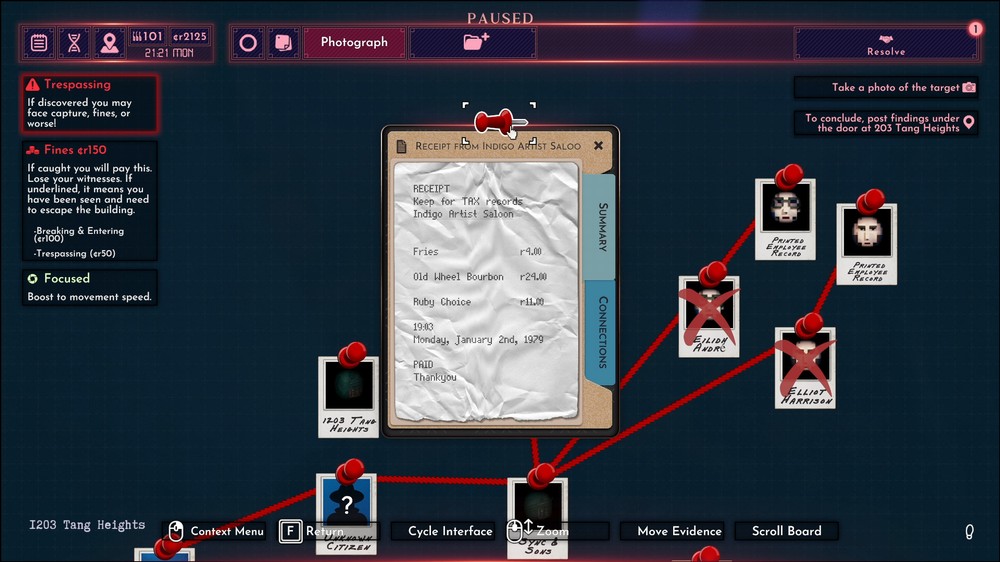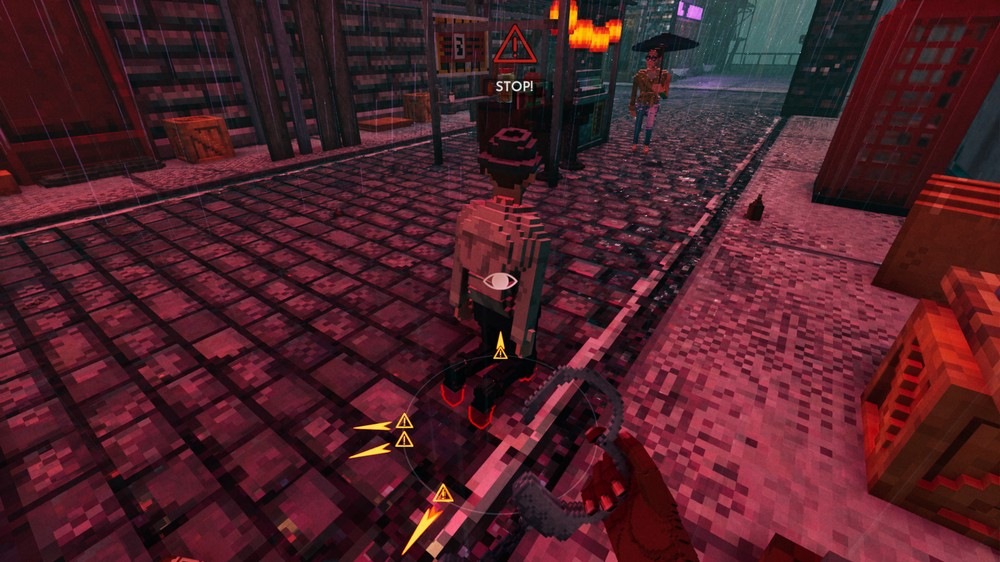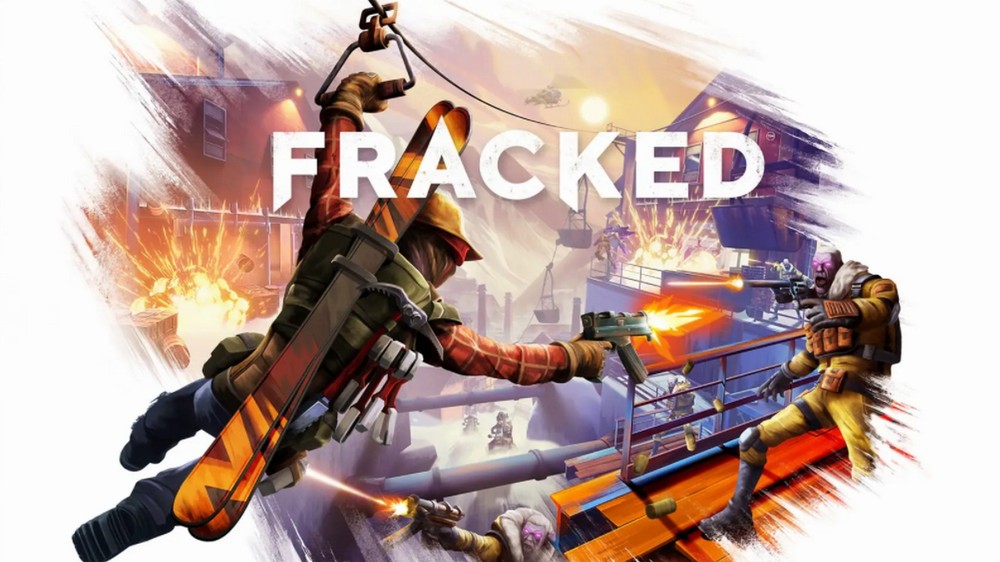The premise for Shadows of Doubt is impressive. Imagine building a non-scripted, procedurally generated, living, breathing city full of citizens who all have their own homes, jobs, routines, responsibilities, etc. So far impressive, but not the most revolutionary thing ever. But, take that living, breathing world and throw a murderer (or murderers) into the mix. You, a detective, are tasked with tracking down these criminals who are among the other citizens.
Presumably due to this complexity, the game takes several minutes to load the first time you generate a new city. Actually, on my first play-through attempt, the game froze in the loading screen as it was generating past events. Apparently, somewhat like Dwarf Fortress, this game will not only generate the current circumstances of the world, but also none of those things exists in a vacuum. Instead, they are each connected to other entities in various ways.
Load times aside, I will say that the game’s voxel graphics are an interesting and appropriate choice. The world is more detailed than, say, Minecraft, and feels a bit similar in design and fidelity to other recent voxel-based games, such as Teardown. However, up until the point where I have experienced, this game world differs in as much as it is not destructible in the way that Teardown is. The game’s atmosphere captures the noir vibes of classic detective fiction, mixed with a dystopian cyberpunk-esque aesthetic, somewhat reminiscent of Blade Runner. Another game that really came to mind, stylistically, as well as atmospherically, was Cloudpunk.
I chose to begin my experience of engaging in the world of Shadows of Doubt by playing through the hand-crafted scenario, rather than jumping into one of the procedurally generated ones. This has the benefit of being designed with a bit more direction from the creators, which allows for the tutorial system to helpfully guide you through the various in-game systems and mechanics that allow you to solve the mysteries that the game creates.
Your character is a former police officer, which allows them access to a series of tools, such as a print scanner (to locate, ID, and capture fingerprints and footprints) as well as a codebreaker device, which is a little bit like a hacking multitool that allows you to gain access to personal computers and the like. You will also find yourself checking the local phone directory to track down people’s phone numbers, addresses, and the like. Every person you see in the game is a person in the phone book, and vice versa. And they all have an address where the live, a place they work, and connections to other people in the game.
As you follow the trail of the murder that has occurred, it will present you with various leads such as a restaurant receipt that you find crumpled up in the victim’s apartment dated from just before the murder occurred, or a performance review from the person’s place of employment. You can then decide what seems like the better lead. The game even tells you that not all leads are going to pan out, some might just be red herrings. After following a series of clues, I ended up at a person’s home who had been seen with my victim just before their death. I thought, this could be my murderer, so I went there and knocked on the door.
There is a whole system that allows you to pick locks, disable security cameras, climb through air vents, and/or search under welcome mats for keys, all to gain unlawful access to someone’s home. However, if they’re home, you might just ask them if you can come in, which is what I did. Turns out this person was very forthcoming and, through engaging them in dialogue, I was able to rule them out as a suspect. They even gave me permission to search the apartment for any further clues. While I was doing that, someone came in, shot my gracious host, and started rifling through the safe in the bedroom. I snuck up on them and put them in handcuffs, thinking that even if this was not my murderer, they were still a murderer, so might as well bring them to justice as well. Turns out, I was able to confirm through the pistol they had on them (matching the caliber to the bullet wounds on my victim) and their fingerprints (matched to ones I found at the scene of the crime) that this was my suspect! I then filled out the paperwork identifying the murderer, the way they committed the crime (the gun), and indicating that I’d arrested them already and turned it in to get credit for a job well done.
I was very impressed by this turn of events, because even though the game was giving me a scripted set of circumstances for the crime, I am fairly sure that the only reason that I caught the suspect at that time was a case of “right place, right time”. If I understand the mechanics of the game correctly, it would have been just as likely that I would have arrived at the apartment to talk to this lead later in the day and they already would have been dead, their apartment already looted, and I would have been still searching. Or, I could have arrived earlier and conducted my search and left and never been any wiser to the eventual murder of the second victim.
This is where the game is immensely interesting, because these people are all connected in logical ways. And they need to be for the game to work because as you play, you are continually discovering and investigating these connections, drawing your own lines between these connections (quite literally) by using a kind of cork-board style clue board.
I thought this was a part of the game that was a bit disappointing, at least on the console version that I played. The UI for managing the cork-board clues, dragging them around, connecting them with threads, is a really cool idea, and I think I probably works much better on the PC version (I would hope), but on the console, I was disappointed and frustrated with trying to put things where I thought they belonged, or trying to find them again in the messy assortment of clues and leads.
Another aspect of the game that was a bit underwhelming was the stealth-style gameplay and the triggering of hostility from people when you “get caught” trespassing or doing other things that you’re not supposed to be doing. The combat system is, well, lacking. Also, people are generally only either indifferent to your presence, or outright hostile. While investigating one residence for clues, I was alerted that security was coming to check it out and was advised to leave. I dove into the air vents and climbed down as far as it would go. This led me into another residence of some random stranger that I had no idea who they were. They found me in their apartment and began chasing me around and hitting me. I didn’t really want to attack this random person and was instead just trying to find the way out of their place in hopes they would leave me alone, which did not work because I couldn’t find the door while they kept hitting me. Finally I hit them once, which made them retreat to the bathroom and sit on the toilet (I don’t know, maybe I hit them a little too hard?) In the end, the combat in the game feels almost like it doesn’t belong. Or maybe if there was going to be combat, it should have been a little more well-developed, rather than feeling like it was kind of tacked on as an afterthought.
Another mechanic of the game that was a bit of surprise that I was not expecting as part of a murder-mystery style game, was the customizable home. Once you finish the tutorial mystery, you are provided a bare-bones apartment that is not furnished in any way. As you complete investigations, you will make money and gain reputation. You can use this to furnish your beginning apartment, or even rent fancier apartments as you go. There is a surprisingly assorted variety of furnishings to purchase and place in and around your virtual home and I was not expecting to be playing a Sims-like game inside of a murder mystery simulator. But…I was.
The game mentions that everyone’s goal is to gain admittance to an illustrious community called The Fields, which I wonder if that is a kind of “endgame” objective for those who want to feel like they’ve “beaten” this game, or if that’s even a possibility? Hang on…yep, a quick Google check does indicate that this is a possibility. So, there you go.
Overall, I think I very much liked the idea of the game. I think the concept was incredibly impressive and engaging. It has its wonky parts, like combat and stealth gameplay, as well as the UI for the conspiracy-corkboard, but it is really engaging in the style and atmosphere, as well as the fact that there is quite literally an endless variation of possibilities to the game. However, like all procedural generation games, where there is an endless variety to the way the pieces are put together, there is a limit to the core mechanics of the game, and I could see after playing through a few different mysteries, feeling as if I’d experienced about all the variations that I could imagine the game offering. But, then again, with my experience of having the killer literally walk in and commit a crime in front of me, maybe it would continue to surprise me in similar ways for a long time.

